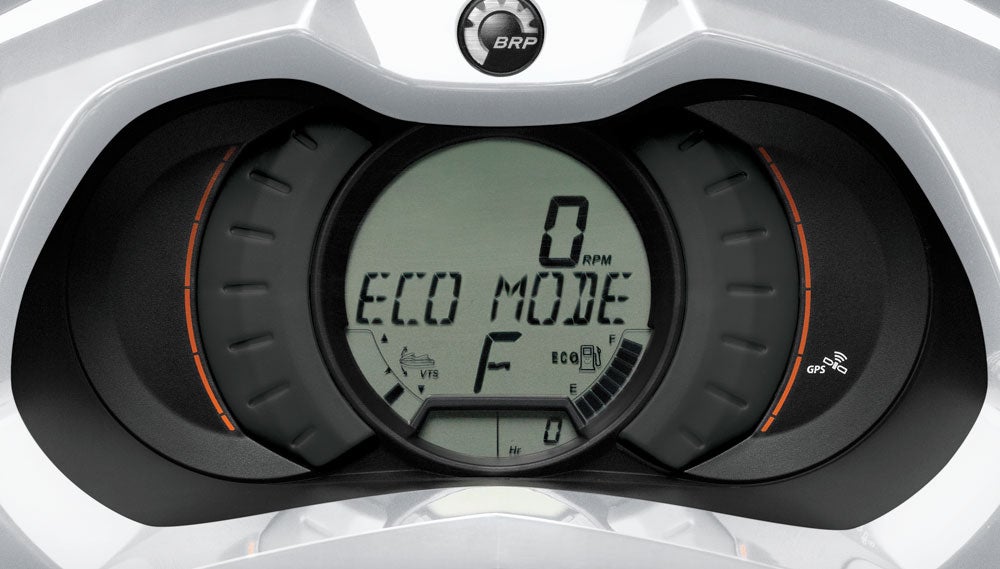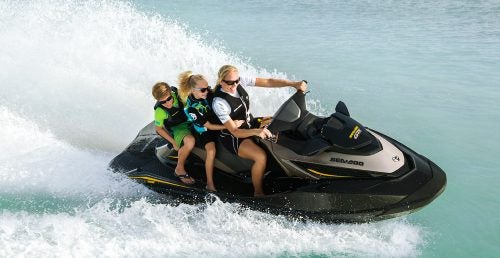2017 Sea-Doo GTI Review
New engine and hull make for big changes – good and bad
Fans of Sea-Doo’s GTI platform have some exciting news in store for 2017. A new engine makes its debut in the craft, as does a change in hull construction. As you’ll see, the two combine to also lower the craft’s price, repositioning the model as an even more value-driven purchase.
Much of what has made the GTI so popular, however, remains very much the same. Curious? Read on.
Big Changes For ’17
Engine: Three-cylinder 899cc
Fuel Capacity: 15.9 gal.
Stowage Capacity: 30.8 gal.
Seating Capacity: 3
MSRP: $8,899
The biggest change coming to the GTI for 2017 is the new engine, the Rotax 900 HO ACE. The same 90 hp engine found in the upgraded Spark, the naturally aspirated three-cylinder is light and compact, and boasts a 30% improvement in fuel economy over the Rotax 1503 it replaces.
It’s a notable drop in horsepower from the former engine, but Sea-Doo is repositioning the GTI for ‘17, sacrificing those horses in return for a drop in retail price. That drop in power also isn’t as drastic as you might think, as the GTI also now adopts the Spark’s lighter (by 150 pounds in this case) PolyTec construction for its hull. For the unitiated, PolyTec is Sea-Doo’s proprietary blend of polypropylene, reinforced with long-strand glass fibers. Acceleration on the craft feels much the same out of the hole, with the pep to pull family members skiing and boarding or satisfy most recreational enthusiasts. Top speed, however, does suffer. I recorded numbers only in the 44 mph range, a significant drop from the previous engine’s 52 mph average. What you lose in speed, however, you make up for in the aforementioned fuel economy.
For those with concerns about PolyTec, Sea-Doo is touting the material’s durability in a series of online videos, one of which sees the hull pounded with a sledge hammer. The press saw an even more interesting version, with an axe taken to the keel of a PolyTec hull, with better results than its fiberglass counterpart. On the GTI the hull is the familiar matte finish, all black, and should prove pretty robust. It will also hide everyday scrapes and scratches fairly well. The fiberglass upper and PolyTec bottom are secured together as is done on the Spark, with a rubber gasket sandwiched between the layers and a series of bolts securing the two halves.
Familiar Standards
While both changes are significant, the GTI doesn’t look or feel all that different. The top deck remains the same stylish, faceted design that moved the GTI away from its former introductory look to a point where it fits in right beside the GTX models. The hourglass-shaped saddle is bolstered and tiered for passenger comfort, and footwells cant inwards to alleviate pressure off the knees and allow the riders legs to take some of the strain off the upper body. Twenty-nine gallons of stowage is found within the front compartment and small glovebox. Below, the familiar 16-degree deadrise hull design gives the boat a looser, more playful feel than the deep-V GTX, but can still be locked in for those wanting an aggressive turn. It also handles rough water with surprising finesse.
The GTI feature-set continues to be impressive for a recreational model. The standout, as always, is Intelligent Brake and Reverse (iBR). A system that electronically links a modified reverse bucket setup to a lever control on the lefthand side of the handlebars, iBR drops that bucket slightly to mimic neutral at startup and then allows the craft to be “shifted” into forward or reverse with the appropriate pull of the throttle or iBR lever. It does wonders for the craft’s low-speed control, particularly in tight confines, and keeps a rider’s eyes on the water ahead and hands on the handlebars. Pull the iBR lever at speed and you get the braking effect, rapidly slowing the craft to avoid a sudden obstacle or slow your momentum into shore. Expect to stop in about 100 feet less at full speed.
Other features include the choice of Touring or Sport modes for acceleration, softening the craft’s power delivery for beginners or providing all available power on tap for more experienced riders. ECO mode selects the most fuel-efficient power curve. A choice of digitally encoded, radio-frequency connection lanyards also provide the engine’s full power, or limit top speed for beginners.
All About Positioning
Clearly there is a shift in the GTI world, one toward new technology on the hull and engine front and a new positioning in terms of price. The downside, as mentioned, is top speed. While the boat retains much of its acceleration, it’s notably slower than previous models. Whether that makes a difference to you as a buyer depends on what you plan to do with the craft. True recreational enthusiasts will probably be content. Those that like a little speed, however, will likely find the craft a step off its previous numbers.
But given that the boat drops a full $500 in price, we’re betting many buyers see the boat just as Sea-Doo envisioned…a value buy, or the next logical step up from the Spark.
Get PersonalWatercraft.com in your Inbox!
Like PersonalWatercraft.com on Facebook
Comments
Most Popular

2025 Yamaha JetBlaster PRO 2-Up Review

2024 Kawasaki Jet Ski STX 160X Review

Remembering the Sea-Doo XP

Whatever Happened to the Wetbike?

2025 Yamaha JetBlaster Review

















 Your Privacy Choices
Your Privacy Choices